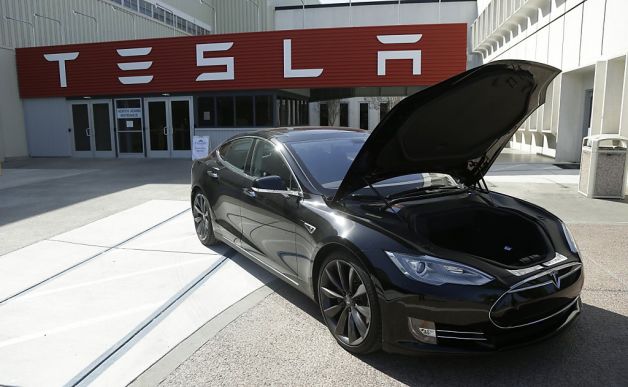Tesla a success for federal loan program

Its fortunes and stock price rising, electric carmaker Tesla Motors reported Wednesday that it has paid back its $465 million federal loan nine years in advance, giving the Obama administration’s clean-tech efforts a rare high-profile win.
Tesla used some of the roughly $1 billion it raised through a new stock offering last week to pay off the loan, which helped the company reopen an old auto plant in Fremont to produce its Model S electric sedan.
Tesla, based in Palo Alto, won the loan in 2010 under a federal funding program for companies trying to build cleaner cars. Created under the Bush administration, the Advanced Technology Vehicle Manufacturing loan program became part of President Obama’s economic stimulus plan, which emphasized green jobs and renewable power.
“I would like to thank the Department of Energy and the members of Congress and their staffs that worked hard to create the ATVM program, and particularly the American taxpayer from whom these funds originate,” said Tesla Chief Executive Officer Elon Musk on Wednesday. “I hope we did you proud.”
First to pay back
Of the five car companies that received loans from the program, including Ford Motor Co. and Nissan North America, Tesla is the first to pay the money back. Tesla wired the government $451.8 million on Wednesday to close out the loan.
The money helped Tesla renovate and reopen the New United Motor Manufacturing plant, which had closed in 2010. But the loan also dragged Tesla into the fierce partisan debate that erupted after another clean-tech company funded by the federal government - Solyndra, located just over 1 mile from Tesla’s plant in Fremont - filed for bankruptcy.
Republican presidential candidate Mitt Romney criticized Tesla’s loan on the campaign trail. Sarah Palin called the company a “loser.” Tesla considered applying for a second loan in 2011, but quickly decided against it.
U.S. Energy Secretary Ernest Moniz on Wednesday cited Tesla as proof that the Energy Department’s loan programs have worked better than critics contend. In addition to the five loans to automakers, the department issued 26 loans for alternative energy projects and two to developers of nuclear power plants. Together, the loan programs represent a $34.4 billion investment by taxpayers.
‘Living proof’
“The department first offered loans to Tesla and other auto manufacturers in June 2009, when car companies couldn’t get other financing and many people questioned whether the industry would survive,” Moniz said. “Today, Tesla employs more than 3,000 American workers and is living proof of the power of American innovation.”
The department’s loan programs have, however, produced a string of embarrassing failures.
Solyndra burned through $528 million building a factory for cylindrical solar panels, money the government was unable to recoup through the company’s bankruptcy proceedings. Abound Solar in Colorado drew down $68 million out of a possible $400 million before tumbling into bankruptcy. SoloPower, based in San Jose, won a $197 million loan guarantee to manufacture thin-film solar panels in Oregon but recently announced it would close its plant there.
Fisker Automotive
And while Tesla appears to be thriving, posting its first-ever quarterly profit this year, another young California car company that received a federal loan is believed to be headed toward bankruptcy. Fisker Automotive, based in Anaheim, won a $529 million loan in 2010 to produce luxury hybrid cars. The company drew down $169 million before running into financial trouble. It hasn’t built a car this year.
Moniz said Wednesday that the loan programs’ losses to date represent just 2 percent of the total $34 billion portfolio. When Congress created the programs, it established a $10 billion loan loss reserve, knowing that some of the companies would fail. The programs’ losses are still less than $1 billion, according to Moniz.
“When you’re talking about cutting-edge clean energy technologies, not every investment will succeed. But today’s repayment is the latest indication that the Energy Department’s portfolio of more than 30 loans is delivering big results for the American economy while costing far less than anticipated,” he said.
You can return to the main Market News page, or press the Back button on your browser.

